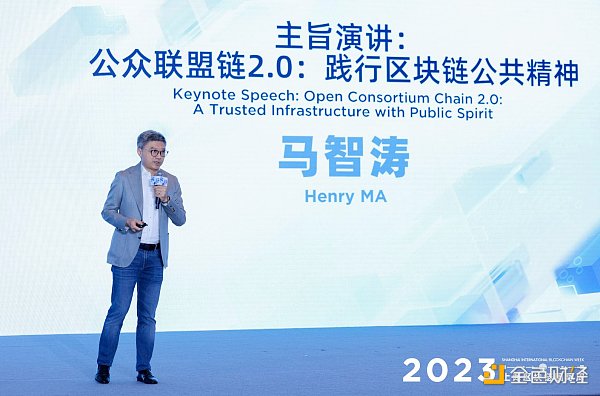Vice President of WeBank Qianhai Possibilities of Public Consortium Chain 2.0
WeBank VP Qianhai on Public Consortium Chain 2.0On September 19, 2023, the “2023 Shanghai Blockchain International Week · 9th Global Blockchain Summit” opened in Shanghai. Ma Zhitao, Deputy President and Chief Information Officer of WeBank Qianhai, gave a keynote speech titled “Public Consortium Chain 2.0: Practicing the Public Spirit of Blockchain”.
For more information, please click: “Highlights of the 2023 Shanghai Blockchain International Week (Continuously Updated)”
LianGuai provided live coverage of the conference. The following is a summary of the speech.

- Highlights of the ‘2023 Shanghai Blockchain International Week’ (continuously updated)
- Full text of Xiao Feng’s speech at the opening ceremony of the 2023 Global Blockchain Summit The next three years are a crucial moment for large-scale application.
- Google Cloud Executive Web3 is for solving business problems, not for speculating token prices.
Ma Zhitao: Good morning, everyone!
First of all, I would like to thank Mr. Xiao for providing us with the opportunity to gather with many new and old friends in the blockchain industry and exchange ideas every year. Every time I receive an invitation from Mr. Xiao, I always feel a bit nervous, as it feels like a time for reflection. All the practitioners in domestic financial institutions present here know that we often need to “reflect”.
WeBank has been focusing on and deepening the field of blockchain since 2015. Every year, we carefully review what we have done and what changes are happening in the industry.
When “reflecting” this year, we set expectations for blockchain technology, whether it is public chains or consortium chains. There are five points:
1. Trust machine: It is widely recognized that blockchain is a machine that establishes trust. We hope to establish a trusted basic system for everyone through blockchain consensus mechanisms and anti-tampering measures.
2. Transaction efficiency: As financial practitioners, especially in China, we know how important it is to promote transaction efficiency. We use tools like WeChat Pay and Alipay every day, and the scale is immense. It is very important to reduce transaction costs and lower costs through blockchain technology while supporting a massive scale of transactions.
3. Open participation: When blockchain was first proposed, it emphasized the characteristic of “open participation”, allowing every user on the Internet to participate. We believe that allowing the public to freely access and participate in this system meets the demands of the blockchain.
4. Regulatability: After the development of blockchain, it has attracted high attention from financial regulators. Can blockchain achieve regulatability? Can it meet the demands of anti-money laundering, anti-terrorism, and investor protection? Regulatability poses high requirements for blockchain.
5. Multi-party collaboration: If there is no demand for multi-party collaboration, traditional information technology is already sufficient. With blockchain, the industry has proposed many concepts of distributed business, using blockchain as the underlying technology to achieve multi-party participation.
Have these expectations from the public been met by blockchain?
Let’s take a look at the two main camps:
(1) Public chains, from the beginning of Bitcoin to the now very mainstream Ethereum.
(2) Consortium chain technology, private chain technology, all hope to meet the five demands mentioned earlier.
So how are they doing? Everyone is making great efforts, and ideals are often full, but is reality a bit disappointing? Not really. However, neither public chains nor consortium chains have completely met the five demands mentioned earlier.
First, public chains.
Represented by Ethereum, they have done well in terms of open participation, encouraging any participant on the Internet to join as long as they have resources to contribute.
As for the trust foundation, the so-called Layer 1 has done a decent job, but because the concept is so perfect, there are actually shortcomings in transaction efficiency at the Layer 1 level, which has led to the emergence of many so-called Layer 2 solutions. At the Layer 2 level, there are still areas that are not ideal in terms of trust. In terms of regulation, it may not be the highest priority to meet regulatory demands within the community. Similar situations can also be seen in multi-party collaboration, including the vibrant development of virtual currencies, digital assets, blockchain games, etc. However, on the basis of public chains, we haven’t seen many cases of digitizing existing industries.
Second, private chains/consortium chains.
Private chains/consortium chains have their strengths, but they also have many areas where they fail to meet the five demands. For example, in terms of trust in machines, the number of participants in a consortium chain is still relatively limited, and trust and credibility are still built on the trustworthiness of limited operational entities.
Transaction efficiency is high because there are fewer nodes involved, which allows for faster processing and lower costs. However, the sacrifice is the level of open participation, as there are only a limited number of participants and institutions. While the technical participation is limited, the level of regulation may be relatively strong, and many applications may to some extent allow regulatory nodes to intervene.
In terms of multi-party collaboration, consortium chains have made many attempts in various industries of the real economy, but the application scenarios are relatively vertical and the participants and ecosystem are narrow. These are the limitations we see in private chains and consortium chains.
Is there a path that can achieve the advantages of both, while effectively meeting the five demands mentioned earlier?
In 2018, WeBank proposed the concept of “public consortium chain” at the global blockchain summit hosted by Wanxiang, which is governed by a consortium but serves the public. Through its development, we believe that the goal of serving the public through consortium governance is not enough, and we still need to enable public participation.
We believe that the concept of “public consortium chain” urgently needs an upgrade to 2.0. On the one hand, it should take into account multi-party collaboration, establish a trust mechanism through consortium governance, embrace regulation, and ensure that transactions on the consortium chain can be regulated. At the same time, the efficiency of transactions on the consortium chain should be guaranteed, allowing us to truly support a large number of transactions in financial scenarios, making costs lower and speeds faster.
One important point is that the public consortium chain needs to be open and involve the public, greatly increasing their participation and allowing the public to see data transparency and code transparency.
Is the public consortium chain 2.0 just a concept with no basis? No, it is not. After proposing the concept of the public consortium chain 1.0 in 2018, we have been practicing in this direction. One important point is the development of underlying technology. I would like to thank General Xiao once again for his cooperation with Wanxiang in developing the blockchain underlying platform BCOS in 2015. With further development, the Golden Chain Alliance was established, and technology has been continuously developed through organizing open source working groups. Today, it has been iteratively upgraded to version 3.1, becoming a very mature technical system. Last month, there was some unexpected news that the research paper of the FISCO BCOS consortium chain underlying platform research team was included and published in the top international conference Super Computing. A paper on Chinese domestic blockchain technology research is being published by a top international academic conference. This is something our team and the whole set of domestic technologies can be very proud of.
Since the announcement of the concept of the public consortium chain in 2018, we have built a set of service scenario examples based on the underlying technology of FISCO BCOS, called “WeBank Blockchain”. Based on the operational data of the past few years, this set of examples has been thoroughly validated. Up to now, the accumulated number of on-chain transactions has exceeded 400 million, and the daily average number of recorded transactions exceeds 300,000, with over 30 dapps on it. We pay special attention to costs. WeBank has been committed to serving the long tail from the beginning, controlling costs and ensuring efficiency. The monthly comprehensive operating cost of a single chain is less than 100,000, which is completely affordable in any scenario as long as you can reach a certain scale.
Currently, the limitation of this system is that most of the applications running on it are WeBank’s own applications, including internally issued collectibles, certification services, and the construction of the metaverse platform. As a data-driven bank, we have a complete system for how to obtain data, how to obtain and share data in a compliant manner, and all these systems run on the WeBank blockchain platform.
In the future, with the development of the WeBank blockchain, we hope to open up public participation, so that more applications and dapps can run on our system and be supervised by the public.
The theme today is the next stop Web3. We firmly believe that the public consortium chain 2.0 system can demonstrate great value in the Web3 era and have the opportunity to become a new type of public infrastructure, serving a rich variety of Web3 scenarios.
Based on this, including the Hong Kong Web3 scenarios mentioned earlier by Mr. Qiu and Mr. Ren, using Cyberport Dollars and stablecoins as anchors of value, governance of the consortium chain is conducted by alliances formed by the government and authoritative institutions, reflecting the public spirit. Of course, we also welcome the public. If the public is willing to contribute resources, they can also join our network through their observing nodes. Dapp developers can also deploy light nodes to support massive transactions in the public consortium chain 2.0 network. We do not rule out the possibility that some dapps may consume a lot of resources, adhering to the logic of “users pay for themselves”. If you consume more resources, then you contribute more computing resources to our network. However, we will ensure that the principles and requirements of “trusted machines” in our network are not violated or damaged.
What will be the next step? The upgrade of the public consortium chain 2.0 will be put into practice, not just proposing ideas, but also taking action. We have officially started the specific work of accessing observation nodes to WeBank’s blockchain, and will gradually open more observation permissions for dApps. There are specific plans on how to support more types of light nodes and observation nodes to enter the network. We will complete these specific tasks within 2023, officially upgrading WeBank’s blockchain to the public consortium chain 2.0 version.
That’s all for my sharing today, thank you!
We will continue to update Blocking; if you have any questions or suggestions, please contact us!
Was this article helpful?
93 out of 132 found this helpful
Related articles
- Community First Building Sustainable Power for Web3 Growth
- Popular Science What is the stateless that Vitalik has frequently mentioned in recent speeches? What does it mean for the decentralization of Ethereum?
- An Overview of Mainstream Cryptocurrency Exchange Account Password Leakage Data and Security Mechanism Analysis
- Blockchain Game of ERC-6551 Use Case
- Exclusive Interview with Web3Brand How do AI and Web3 achieve mutual development in the wave of technological advancement?
- a16z Zero-knowledge proofs are just a magic trick
- Stanford Blockchain Week Highlights MEV, L2, ZKP, On-chain Order Book…






